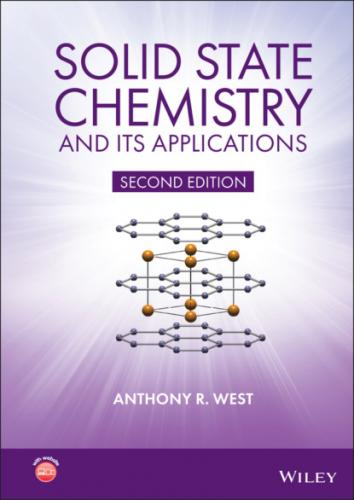3 Chapter 3Figure 3.1 Electron density contour map of LiF (rock salt structure): a sect...Figure 3.2 Variation of electron density along the line connecting adjacent ...Figure 3.3 Ionic radii as a function of coordination number for cations M+ t...Figure 3.4 Radius ratio calculation for octahedral coordination. Figure 3.5 Lattice energy (dashed line) of ionic crystals as a function of i...Figure 3.6 Variation of Pauling electronegativities with position in the Per...Figure 3.7 Mooser–Pearson plot for AB compounds containing A group cations. ...Figure 3.8 Bond valence–bond length universal correlation curve for bonds be...Figure 3.9 Splitting of d energy levels in (a) an octahedral and (b) a tetra...Figure 3.10 Radii in octahedral coordination of (a) divalent and (b) trivale...Figure 3.11 Lattice energies of transition metal difluorides determined from...Figure 3.12 Energy level diagram for the d levels in a d 9 ion experiencing ...Figure 3.13 Orientation of d orbitals in a tetrahedral field. Figure 3.14 The structure of red PbO, showing the presence of the inert pair...Figure 3.15 Plot of ψ and 4πr2ψ2 for 1s, 2s and 3s orbitals of a hydrogen at...Figure 3.16 The three p and five d orbitals. Note the axes for labelling eac...Figure 3.17 Bonding σ s and antibonding
4 Chapter 4Figure 4.1 Idealised reaction mixture composed of grains of MgO and Al2O3. I...Figure 4.2 Nucleation of MgAl2O4 spinel on (a) MgO and (b) Al2O3. Letters A,...Figure 4.3 Fishes to birds: Escher drawing. Figure 4.4 Spinel product layer separating MgO and Al2O3 reactant grains. Figure 4.5 (a) Solution chemistry of Al showing amphoteric behaviour and eff...Figure 4.6 Reagents and esterification mechanism in the Pechini process. Figure 4.7 (a) Pressure–temperature relations for water at constant volume. ...Figure 4.8 The Bayer process for the extraction of α‐Al2O3 from bauxite, whi...Figure 4.9 SEM images of various metal oxide nanostructures. Figure 4.10 Structures of (a) graphite, in oblique projection showing the tw...Figure 4.11 Stacking of octahedral layers in LDHs showing (a) two‐layer repe...Figure 4.12 Synthesis of polymer‐intercalated LDH showing (a) in situ polyme...Figure 4.13 (a, b) Simple vapour‐phase transport experiment for the transpor...Figure 4.14 Single‐source precursor molecules for MOCVD. Figure 4.15 (a) A three‐coordinate Si atom in a‐Si; (b) the band structure s...Figure 4.16 (a) Phase diagram for carbon; (b) schematic surface of diamond f...Figure 4.17 (a) Cathode sputtering equipment and (b) vacuum evaporation equi...Figure 4.18 Deposition of TiO2 films by ALD. Figure 4.19 Ultrasonic spray pyrolysis: (a) photograph of an aerosol fountai...Figure 4.20 Fluorescence of CdSe quantum dots controlled by particle size wh...Figure 4.21 Process diagram for preparation of SnO2 gas sensors comparing we...Figure 4.22 Czochralski method for crystal growth. Figure 4.23 (a) Stockbarger method. T m = crystal melting point. (b) Bridg...
5 Chapter 5Figure 5.1 Structural features of inorganic solids across the length scales ...Figure 5.2 The electromagnetic spectrum. Figure 5.3 (a) Generation of Cu Kα X‐rays. A 1s electron is ionised; a 2p el...Figure 5.4 (a) Schematic design of a filament X‐ray tube. (b) Use of Ni to f...Figure 5.5 Schematic diagram of a synchrotron storage ring. Figure 5.6 (a) Lines on an optical grating act as secondary sources of light...Figure 5.7 Diffraction of light by an optical grating. Figure 5.8 Derivation of Bragg’s law. Figure 5.9 The X‐ray diffraction experiment. Figure 5.10 The different X‐ray diffraction techniques. Figure 5.11 The powder method. Figure 5.12 Formation of a cone of diffracted radiation. Figure 5.13 Schematic Debye–Scherrer photograph. Figure 5.14 (a) Theorem of a circle used to focus X‐rays. (b) Arrangement of...Figure 5.15
